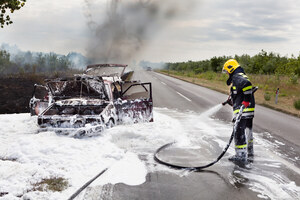 PFAS and PFOA compounds, also known as “forever chemicals,” have become common in the environment. They do not biodegrade and are now found in the bloodstreams of roughly 98 percent of Americans. They can also be deadly, with links to liver damage, developmental issues and various forms of cancer. The EPA has dubbed PFAS an “urgent public health and environmental issue.”
PFAS and PFOA compounds, also known as “forever chemicals,” have become common in the environment. They do not biodegrade and are now found in the bloodstreams of roughly 98 percent of Americans. They can also be deadly, with links to liver damage, developmental issues and various forms of cancer. The EPA has dubbed PFAS an “urgent public health and environmental issue.”Focus on firefighting foam
In 2018, the City of Stuart brought a lawsuit against 3M and several other chemical manufacturers, claiming that the city’s water supply had been contaminated by firefighting foam containing PFAS. The foam had been used for decades in training exercises by the city’s fire department. At the time, aqueous firefighting foam (AFFF) was seen to be an effective way to fight extraordinarily hot, fuel-based fires, like those that might occur during a horrific Navy aircraft carrier disaster.
The chemicals appear to have seeped into the Surficial Aquifer, deep below Stuart. Stuart’s municipal water facility draws on a series of interconnected wells. These wells, in turn, draw from the aquifer. Some of those wells were in the vicinity of the open space that the city’s Fire and Rescue Department used to train firefighters in the use of firefighting foam. The unanswered question is whether the aquifer, itself, is contaminated.
The city was not required to test for the presence of PFAS or PFOA in the municipal water supply until 2012, long after that training began. The Stuart city government did not learn that its water contained high levels of these chemicals until 2016. It immediately took several wells out of service.
But the damage had already been done. Testing indicated some of the city’s wells showed levels of PFAS higher than 1,000 ppt parts per trillion, far in excess of the EPA’s limit of 70 ppt. It is not clear how long Stuart residents had been drinking poisoned water.
Stuart has prided itself on its sport potential and on the cleanliness of its water. It advertises itself as the “Sailfish Capital of the World.” The healthy, clean, sporting water reputation may have been seriously damaged.
In addition to the harm that these chemicals have done to Stuart residents’ health and the city’s sport reputation, Stuart must now spend staggering amounst of money to build and maintain a water treatment facility capable of scrubbing PFOS and PFOA from the water.
Cost of cleanup
The city’s goal since 2016 has reportedly been to get PFAS contamination in its drinking water supply as close to zero ppt as possible. But getting there has proved to be extraordinarily expensive for a small city with a small budget.
Conventional water-purification techniques, such as the use of chlorine, do not work on PFAS. To clean up its 30 wells, the city implemented a new water scrubbing system. This system, known as an ion-exchange treatment, relies on magnetlike resins to attract PFAS molecules. The resins, once they have absorbed all the contaminants possible, must be burned and then replaced with fresh resins. The city has already spent roughly $20 million keeping its PFAS levels below 30 ppt.
Stuart estimates that the cost of replacing the resins is approximately $2 million per year. How many years this will take is not clear. Simply put, the amount of the settlement may not be enough.
Many towns and cities affected
READ MORE PFAS HEALTH RISKS LEGAL NEWS
In late 2022, Baltimore city filed a lawsuit against multiple manufacturers of “forever chemicals” and the companies that put them in firefighting foams, claiming that they knew and concealed the fact that the widely used chemicals were toxic and contaminating water supplies. The lawsuit was filed on the same day that a similar lawsuit was filed in Philadelphia.
Under the circumstances, it is hardly surprising that the manufacturers and distributors of PFAS and PFOS chemicals seem eager to settle. The lesson that many may derive from the City of Stuart’s experience is that the costs can be much greater than anticipated.

READER COMMENTS
CANDY DARR
on
I am now battling cancer for over 6 years. I live close to Rivers still in area.